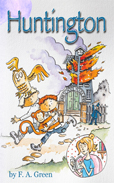
 |
Nesta Fletcher is a bit of an outcast, more so when she is accused of having burnt down her school. With her father struggling to find work and her mother absent, Nesta occupies her time with a book lent to her by her teacher, Mrs. Cowling. In the book, Nesta discovers a story somewhat similar to hers about a group of children scraping by on their own, each with an animal friend. The two oldest, Owlie and Monk, are similarly accused of having burnt down their own school. The local Reverend requests that Professor Oxborough visit the boys’ home and take them into his custody in order to give them food, shelter, an education, and help find their parents, but the boys offer up what resistance they can.
After being corralled by Professor Oxborough, they are taken to the barn to get their education, but trouble soon stirs up when a giant beast is released from a traveling circus. Nobody is safe from the beast prowling around town. Worse, Reverend Lamb has gone missing, and nobody seems to be able to find him. The local law enforcer, Constable Monk, claims to be on the case, but his behavior is questionable, and the boys—now renamed Huntington and Manfred—swear that he is, in fact, their abusive and scheming father. As more children turn up missing, and Professor Oxborough ends up missing just like Reverend Lamb, it will take cooperation among the unruly children to locate the missing adults and find safety from the wild beast.
Dripping with Dickensian squalor and adorned in religious allegory, this tale can be a little bewildering to the reader as it bounces between Nesta’s story of isolation and sworn innocence and Huntington and Manfred’s wild, almost animalistic behavior. The narrative also has plenty of mysteries that it plays close to the vest until the very end, and so readers will need to take it on faith that when details don’t seem to line up, it all approaches a calculated endpoint, which indeed it does. Behind all of the metaphors and symbolism, there are two distinct messages to this story: forgiveness and peace are found only through surrendering oneself to Jesus, and doing so requires stepping away from and leaving behind baser, beastly behaviors.
The story itself is written in a way that can seem almost dreamlike, with peculiar details being called out to the reader’s eye and dialogue winding around and around in a cheeky, playful, and sometimes misdirecting way. That approach adds to the fascinating obscurity about what is happening in the story, which clues are part of the mystery of the missing children and adults, and which are just peculiarities common for such wild and unsupervised youth.
Though it seems to coil around itself for a while, the last third of the book hits an entertaining pace, and readers may even feel the need to start the book from the beginning, taking what they’ve learned about Huntington and his brothers and re-examining the story from its genesis. Being so casual about its layers proves the craft with which this story was written and allows the reader to try and put it all together just as its characters do the same.